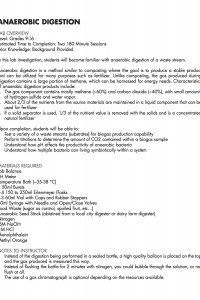In this lab investigation, students will become familiar with anaerobic digestion of a waste stream.
Anaerobic digestion is a method similar to composting where the goal is to produce a stable product that can be utilized for many purposes such as fertilizer. Unlike composting, the gas produced during digestion contains a large portion of methane, which can be harnessed for energy needs. Characteristics of anaerobic digestion products include:
- The gas component contains mostly methane (~60%) and carbon dioxide (~40%), with small amounts of hydrogen sulfide and water vapor.
- About 2/3 of the nutrients from the source materials are maintained in a liquid component that can be used for fertilizer
- If a solid separator is used, 1/3 of the nutrient value is removed with the solids and is a concentrated natural fertilizer
Learning Objectives
Upon completion, students will be able to:
- Test a variety of a waste streams (substrates) for biogas production capability
- Perform titrations to determine the amount of CO2 contained within a biogas sample
- Understand how pH affects the productivity of anaerobic bacteria
- Understand how multiple bacteria can living symbiotically within a system
| Download the Full Package |
Concepts/Skills
Anaerobic Digestion, Energy Content
Prior Knowledge
Background provided
Time Required
Two 180-minute sessions
Required Supplies
Lab balance, pH meter, temperature bath, burets, Erlenmeyer flasks, 60mL vials with caps and rubber stoppers, 60mL syringe with needle and open/close valves, food waste (sugar as control, spoiled fruit, etc.), anaerobic seed stock, nitrogen, NaOH, HCl, phenolphthalein, methyl orange

